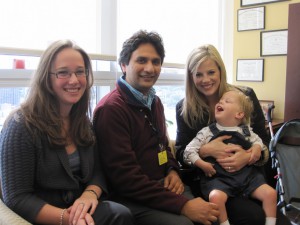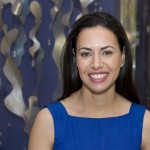
Mary Elizabeth Stone and her son John, with genetic counselor Meghan Connolly and Pankaj Agrawal, principal investigator of the Gene Discovery Core. (Courtesy ME Stone)
Sequencing a patient’s genome to figure out the exact source of his or her disease isn’t standard operating procedure — yet. But falling sequencing costs and a growing number of successes are starting to bring this approach into the mainstream, helping patients and families while advancing a broader understanding of their diseases.
The Stone family is a case in point. When John and Warren Stone were born, their parents were envisioning life raising identical twins, when suddenly everything changed. On their second day of life, the twins started to have seizures with stiffening of their arms and legs; more alarmingly, they would stop breathing from time to time, requiring a ventilator to help them breathe. Further work-up revealed that both John and Warren were having persistent seizures consistent with Ohtahara syndrome, a rare, debilitating seizure disorder.
Warren died a few weeks later, and the family transferred John’s care to Boston Children’s Hospital. An extensive clinical and genetic work-up here and at several other hospitals involved in his care — including sequencing all the genes known to cause Ohtahara syndrome – identified no cause for John’s unique seizures. At that point, the family was referred to The Manton Center for Orphan Disease Research at Boston Children’s and enrolled in its Gene Discovery Core (GDC), where a whole-genome sequence was performed on John’s DNA.
Identifying the cause of John’s condition was solely possible by genomic sequencing.
With the help of principal investigator Pankaj Agrawal, MD, and after nearly a year of attempts and several false leads, the GDC team identified the causative mutation in John and his deceased twin.
“Identifying the cause of John’s condition was solely possible by genomic sequencing,” Agrawal told me. “John’s clinical course was very confusing, with a few tests pointing to a mitochondrial disease that didn’t make sense. On whole genome sequencing, we were able to rule out the mitochondrial disease, and instead identified a gene mutation that was previously associated with a different kind of seizures — but had not been previously described to cause Ohtahara syndrome.”
Enrollment and testing of additional family members confirmed that the mutation occurred de novo – meaning it most likely occurred during conception and wasn’t inherited. This allowed our counselors to assure this young family — which is planning to have more kids — that the risk of recurrence in future pregnancies was very small. It also gave them a sense of closure, helping them come to terms with John’s condition and Warren’s death.
Moreover, the finding helped in understanding the mechanism of John’s seizures, pointing to defects in a channel that acts as a “gatekeeper,” allowing sodium to enter brain cells, making them hyper-excitable. Agrawal hopes to get a grant to study this further in zebrafish, which are genetically very similar to humans. “My hypothesis is that this discovery will help identify anti-seizure drugs that can specifically target these defects,” he told me.
“We’re expecting some interesting submissions from the back of the freezer.”
The Stones’ example is just one of the 1,000 individual DNA sequences that we expect to generate and analyze at Boston Children’s Hospital by the end of 2012, thanks to a pilot program from the Gene Partnership Research Sequencing Project (ReSeq), together with the Manton Center and the Department of Clinical Genetics. The pilot is currently taking requests for no-cost whole-genome sequencing (or whole exome sequencing, a more cost-effective approach limiting itself to just the protein-coding genes). Both clinicians and research investigators can nominate patients to be sequenced.
“This is an exciting program that will lead to answers and better treatments for some difficult cases,” says Gene Partnership Director David Margulies, MD.
There is no shortage of such cases at Boston Children’s. In the past, motivated clinicians collaborated with other hospitals to get sequencing done. Now, we can take care of those cases in-house.
Genetic counselor Meghan Connolly, MS, CGC, who is helping many patients with rare disease at the Manton Center enroll in ReSeq, also expects the project to solve many “cold cases.”
“We’re expecting to get some interesting submissions from the back of the freezer — samples from patients who never got their cases solved,” she says. “The technology to figure them out has finally arrived.”
 Catherine Brownstein, MPH, PhD, is the Gene Partnership’s Research Sequencing (ReSeq) Project Manager at Boston Children’s Hospital.
Catherine Brownstein, MPH, PhD, is the Gene Partnership’s Research Sequencing (ReSeq) Project Manager at Boston Children’s Hospital.
Read about another genomics success story, and about the CLARITY prize we’re offering to competing teams to report genomic findings in a way that a physician can easily use to guide recommendations about care.






